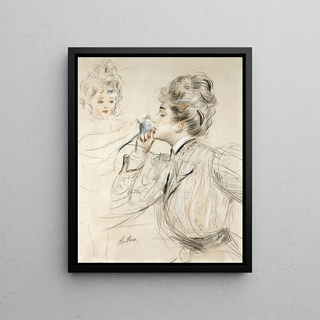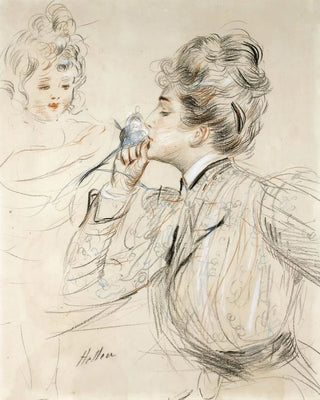Art print | The Perfume - Paul César Helleu


View from behind

Frame (optional)
In the fascinating world of art, some works emerge as flashes of light, captivating the mind and awakening the senses. "The Perfume" by Paul César Helleu falls into this category, a piece that transcends a simple painting to become a true ode to beauty and elegance. This artwork, both delicate and powerful, immerses us in a world of refinement where every detail is carefully thought out. Helleu, master of pastel, succeeds in capturing the very essence of femininity and sensuality through a composition rich in nuances and emotions. The artist thus invites us to explore the subtleties of perfume, a symbol of seduction and intimacy.
Style and uniqueness of the work
Paul César Helleu's style is distinguished by its lightness and fluidity, characteristics that make "The Perfume" an unforgettable piece. The color palette chosen by the artist evokes a soft, dreamy atmosphere, where pastel shades blend harmoniously to create an effect of depth and movement. The delicate lines and refined contours of the female figures demonstrate exceptional technical mastery, while the depiction of perfume, through elements such as bottles and flowers, adds a sensory dimension to the artwork. Helleu manages to establish a dialogue between color, light, and form, offering a visual experience that goes beyond mere observation. Each glance at this work reveals new facets, inviting prolonged contemplation.
The artist and his influence
Paul César Helleu, an emblematic figure of the late 19th-century artistic movement, knew how to mark his era with his unique style and innovative vision. Raised in the artistic vibrancy of Paris, Helleu mingled with renowned artists such as Claude Monet and Edgar Degas, which undoubtedly influenced his approach to art. His works, often centered on the representation of women, testify to a particular sensitivity to beauty and grace. Helleu also skillfully leveraged the new techniques of his time, integrating elements of Impressionism while developing his own visual language. His legacy endures

Matte finish

View from behind

Frame (optional)
In the fascinating world of art, some works emerge as flashes of light, captivating the mind and awakening the senses. "The Perfume" by Paul César Helleu falls into this category, a piece that transcends a simple painting to become a true ode to beauty and elegance. This artwork, both delicate and powerful, immerses us in a world of refinement where every detail is carefully thought out. Helleu, master of pastel, succeeds in capturing the very essence of femininity and sensuality through a composition rich in nuances and emotions. The artist thus invites us to explore the subtleties of perfume, a symbol of seduction and intimacy.
Style and uniqueness of the work
Paul César Helleu's style is distinguished by its lightness and fluidity, characteristics that make "The Perfume" an unforgettable piece. The color palette chosen by the artist evokes a soft, dreamy atmosphere, where pastel shades blend harmoniously to create an effect of depth and movement. The delicate lines and refined contours of the female figures demonstrate exceptional technical mastery, while the depiction of perfume, through elements such as bottles and flowers, adds a sensory dimension to the artwork. Helleu manages to establish a dialogue between color, light, and form, offering a visual experience that goes beyond mere observation. Each glance at this work reveals new facets, inviting prolonged contemplation.
The artist and his influence
Paul César Helleu, an emblematic figure of the late 19th-century artistic movement, knew how to mark his era with his unique style and innovative vision. Raised in the artistic vibrancy of Paris, Helleu mingled with renowned artists such as Claude Monet and Edgar Degas, which undoubtedly influenced his approach to art. His works, often centered on the representation of women, testify to a particular sensitivity to beauty and grace. Helleu also skillfully leveraged the new techniques of his time, integrating elements of Impressionism while developing his own visual language. His legacy endures






